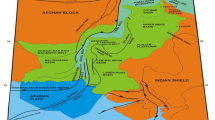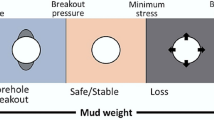Abstract
Inversion methods for conventional reservoirs cannot be used in tight reservoirs because of small differences in wave impedance between tight reservoirs and surrounding rocks. Tight reservoirs in western China are characterized by strong heterogeneity; thus, it is difficult to predict favorable zones using conventional reservoir inversion methods. In this study, we propose an inversion method based on the Xu–White model. First, we modify the test parameters of the Xu–White model until model P- and S-wave velocities and density values agree with well-logging data. Then, we calculate P- and S-wave velocities, density, and Poisson ratio for different lithologies and oil saturation and construct different geological models for interbedded sand and shale. Subsequently, we use approximations to Zoeppritz equations to perform prestack forward modeling and analyze the response characteristics of prestack gathers for different physical properties, lithology, and oil saturation. We analyze the response of thirteen types of elastic parameters to porosity, clay content, and oil saturation. After the optimization of the real prestack gathers in the Z area of western China, we select an elastic parameter that is the most sensitive to lithology and oil saturation to predict the distribution of oil-producing reservoirs with high accuracy.
Similar content being viewed by others
References
Aki, K., and Richards, P. G., 1980, Quantitative Seismology: Theory and Methods: W. H. Freeman and Company, the San Francisco, 100–170.
Bill, G., Marco, P., and John, V., 2010, Seismic petrophysics and isotropic-anisotropic AVO methods for unconventional gas exploration: The Leading Edge, 29(12), 1500–1508.
Bruce, S. H., Robin, P., and Geoffrey, C., 2002, 3-D seismic horizon-based approaches to fracture-swarm sweet spot definition in tight-gas reservoirs: The Leading Edge, 21(1), 28–35.
Bai, J. Y., Song, Z. X., and Su, L., 2012, Error analysis of shear-velocity prediction by the Xu-White model: Chinese Journal of Geophysics (in Chinese), 55(2), 589–595.
Ba, J., Yan, X. F., Chen, Z. Y., et al., 2013, Rock physics model and gas saturation inversion for heterogeneous gas reservoir: Chinese J. Geophys.(in Chinese), 56(5),1696–1706.
Chen, Y., Huang, T. F., and Liu, E. R., 2009, Petrophysics: University of Science and Technology of China Press, Hefei, 310–375.
Cheng, B. J., Xu, T. J., and Li, S. G., 2012, Research and application of frequency dependent AVO analysis for gas recognition: Chinese Journal of Geophysics (in Chinese), 55(2), 608–613.
Gassmann, F., 1951, Elastic waves through a packing of spheres: Geophysics, 16(1), 673–685.
James, J. R., 2007, Developing new 3D seismic fracture interpretation methods for tight gas reservoirs: The Leading Edge, 26(2), 162–166.
Keys, R. G., and Xu, S. Y., 2002, An approximation for the Xu-White velocity model: Geophysics, 67(5), 1406–1414.
Kuster, G. T., and Toksöz, M. N., 1974, Velocity and attenuation of seismic waves in two phase media: Part 1: Theoretical formulation: Geophysics, 39(1), 587–606.
Militzer, B., Wenk, H. R., Stackhouse, S., Stixrude, L., 2011, First-principles calculation of the elastic moduli of sheet silicates and their application to shale anisotropy: American Mineralogist, 96(1), 125–137.
Qiao, Y.D., Gao, Y.F., and An, H.W., 2007, Technology of optimized shear wave velocity prediction based on Xu-White model: Journal of Oil and Gas Technology(in Chinese), 29(5), 100–105.
Qiao, S. R., Zhang, H., and Zhao, S., 2008, Reservoir prediction techniques and their application to tight sandstones of the Xujiahe Formation in DY area, western Sichuan Basin: Oil & Gas Geology ( in Chinese), 29(6), 774–780.
Sait, B., and Matthew, J. P., 2013, Fault and fracture distribution within a tight-gas sandstone reservoir: Mesaverde Group, Mamm Creek Field, Piceance Basin, Colorado, USA: Petroleum Geoscience, 19(3), 203–222.
Shuey R. T., 1985, A simplification of the Zoeppritz equations: Geophysics, 50(4), 609–614.
Xavier, E. R., Kurt, J. M., and Joël, H. L., 2011, Inversion and attribute-assisted hydraulically induced microseismic fracture characterization in the North Texas Barnett Shale: The Leading Edge, 30(3), 292–299.
Xu, S. Y., and Payne, M. A., 2009, Modeling elastic properties in carbonate rocks: The Leading Edge, 28(1), 66–74.
Xu, S. Y., and White, R. E., 1995, A new velocity model for clay-sand mixtures: Geophysical Prospecting, 43(1), 91–118.
Xu, S. Y., and White, R. E., 1996, A physical model for shear-wave velocity prediction: Geophysical Prospecting, 44(5),687–717.
Yan, X. F., Yao, F. C., Cao, H., et al., 2011, Analyzing the mid-low porosity sandstone dry frame in central Sichuan based on effective medium theory: Applied Geophysics, 8(3), 163–170.
Yang, S. G., and Zhou, X. X., 1995, Forward model for AVO characteristic stack section and the application: Oil Geophysical Prospecting (in Chinese), 30(6), 772–774.
Yu, H., Ba, J., Carcione, J., et al., 2014, Rock physics modeling in heterogeneous carbonate reservoirs: Porosity estimation and hydrocarbon detection: Applied Geophysics, 11(1), 9–22.
Zheng, X. D., 1991, Forward AVO method and its application: Oil Geophysical Prospecting (in Chinese), 26(6), 766–776.
Author information
Authors and Affiliations
Corresponding author
Additional information
Zhu Chao received his B.E. from China university of Petroleum (Beijing) in 2009. He is presently an engineer at PetroChina Hangzhou Research Institute of Geology. His research mainly focuses on seismic interpretation and reservoir prediction.
Rights and permissions
About this article
Cite this article
Zhu, C., Guo, QX., Gong, QS. et al. Prestack forward modeling of tight reservoirs based on the Xu–White model. Appl. Geophys. 12, 421–431 (2015). https://doi.org/10.1007/s11770-015-0505-1
Received:
Accepted:
Published:
Issue Date:
DOI: https://doi.org/10.1007/s11770-015-0505-1




